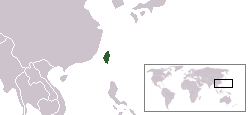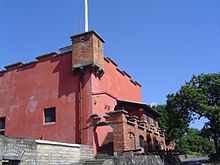Dutch Formosa


The rule of the Dutch East India Company over Formosa (today's Taiwan ) lasted from 1624 to 1662 and was the only longer period of rule of a European colonial power on the island of Taiwan. Although the presence of the Dutch was relatively short-lived and the area they actually controlled comprised only about a third of the island at the time of greatest expansion, the era was nevertheless a significant turning point in all of Taiwanese history. The name is derived from the Portuguese "Ilha Formosa" ( beautiful island ).
history
In 1622 Cornelis Reyerszoon kidnapped a number of Han on the coast of Fujian , Ming Empire , and attacked Macau, Portugal, on behalf of the Batavian Governor General Jan Pieterszoon Coen . The Portuguese repulsed the attack, Reyerszoon moved to the Pescadoren Islands ( Han script : 澎湖, Penghu ) and had a fort built there in July and August of that year with the help of Han forced laborers. He remained in command of the fort until 1624 when the Ming government reclaimed control of Penghu. The fort was demolished and the Dutch began building a base on Formosa on the Taiwan Bay , which later gave the entire island its name. In the area there were villages of the Taiwanese natives , but also Han and Japanese traders, pirates and fishermen. The Dutch colony existed between 1624 and 1662. Fort Zeelandia on the Bay of Taiwan served as the main base . In 1653 another fortress, Fort Provintia, was built not far from Fort Zeelandia .
On May 10, 1626 two Spanish galleys from Manila landed on the north coast of what they called Isla Hermosa and a little later founded a fortified base in the bay of today's Keelung , which was named San Domingo . In 1629 a second base Castillo was founded in today's Tamsui . From these bases the Spanish traded with the natives and carried on the Catholic mission. The Dutch East India Company saw unpleasant trade competition in the Spanish branches. In addition, Spain was in the Eighty Years War with the States General . Therefore, in 1629 a military expedition took place on August 3, 1642 Castillo (Tamsui) and on August 24, 1642 the port of Santissima Trinidad in Keelung were captured by the Dutch.
For the Dutch East India Company, Formosa was initially of particular importance as an intermediate trading center in trade with Japan, as the island was about halfway between Japan and Java. Here goods from India and Southeast Asia were traded for products of Japanese handicraft (silk fabrics, swords, etc.). On the other hand, Formosa became more and more important as a raw material supplier. Here were rattan wood , exported deer hides, deer horns and various medicinal plants of Chinese medicine. Among other things, spices, cotton and paper were imported. In 1649, the VOC made 39% of its profits from the Japanese trade and 26% from the formosa trade. The latter had a volume of 467,500 guilders - in 1640 it was only 13,000 guilders.
Settlement by Han immigrants
Despite Taiwan's proximity to mainland China, Han settlers first began immigrating to Taiwan on a large scale during Dutch rule, because the Dutch themselves actively wooed Chinese settlers. The Dutch needed the Chinese as an intermediary for trade with the indigenous people on the one hand and with mainland China on the other. The Dutch were able to benefit from both by collecting taxes and customs duties. They also used Chinese farmers to make the land arable. The governor Nicholas Verburg described the benefits of the Chinese immigrants for the Dutch with the words that the Chinese are "the only bees on Formosa that give honey".
Control and riots
After the Dutch had secured control of the indigenous tribes on their territory, they maintained this control by appointing an elder as village head in each village, whom they decorated with a kind of government staff as a token of dignity. Once a year a state parliament was held, at which all village chiefs were entertained by the Dutch and the chieftainship was confirmed or transferred to other chiefs.
After the pacification of the indigenous tribes at the beginning of the Dutch rule, there were no notable revolts against the Dutch on the part of the indigenous people. But there were tensions between the indigenous people and the Chinese on the one hand and between the Chinese and the Dutch on the other. The Chinese were the main agents of trade between the indigenous people and the Dutch, as well as the Dutch and mainland China. For this activity they acquired licenses from the Dutch and had to pay taxes. In some places there were cases of defraudation and exploitation of the indigenous people by the Chinese, so that resentment arose among the indigenous people towards the latter, which sometimes resulted in violent attacks against the Chinese. As a protective power, the Dutch mostly intervened on the Chinese side and stifled the unrest, but there are also known cases in which Chinese traders were punished for their misconduct.
The level of taxes eventually led to uprisings by the Chinese against the Dutch. The surveys were suppressed, but a state of mutual distrust remained, especially as the Chinese in Taiwan were in constant contact with the mainland and with the Chinese general Zheng Chenggong , who was operating in southern China and who was becoming an ever greater threat to the Dutch.
Koxinga's invasion and end of rule
Zheng Chenggong (Koxinga), a loyalist of the Ming Empire in the fight against the newly established Qing Empire , had to withdraw from mainland China after long resistance and landed in Taiwan in 1661 to make the island his new base of operations. After his attack on Fort Zeelandia and a nine-month siege, the outnumbered Dutch surrendered under Governor Frederick Coyett in 1662 and had to leave Formosa. Zheng founded the Tungning Kingdom from the territories he had taken over .
meaning
The rule of the Dutch in Taiwan lasted less than four decades, and at the time of their greatest power only an estimated one-third of the entire island had actually been under their control. Still, their presence in Taiwan had far-reaching consequences:
- With the Dutch, Han settlers came to Taiwan on a large scale for the first time. Dutch rule thus also marked the beginning of continuous Han immigration over the following two hundred years.
- The reports and records of the Dutch broadened Europeans' knowledge of Taiwan and the southern Chinese coast.
- The Dutch brought Protestant Christianity to Taiwan and translated the New Testament into the Siraya native language using a Latin alphabet-based writing system for the language. These written documents are still valuable material for research into the now extinct Siraya language.
A few architectural traces of Dutch rule have survived on Taiwan to this day. Best known are the Fort Zeelandia in Anping ( Tainan ) and the Fort the redhead called Fort San Domingo in Tamsui .
see also: History of Taiwan
literature
- Andrade, Tonio: How Taiwan Became Chinese: Dutch, Spanish, and Han Colonization in the Seventeenth Century . New York: Columbia University Press, 2008.
- Schmalkalden, Caspar: The wondrous journeys of Caspar Schmalkalden to West and East India 1642–1652 . Leipzig: FA Brockhaus Verlag, 1983.
- Weggel, Oskar: The History of Taiwan. From the 17th century until today . Böhlau, Cologne, Weimar, Vienna 1991, ISBN 978-3-412-02891-6 .
See also
Web links
Individual evidence
- ^ William Campbell: Formosa under the Dutch: Described from Contemporary Records. With Explanatory Notes and a Bibliography of the Island. London 1903 (Reprint, Taipei: Ch'eng-wen Publ., 1967)
- ↑ Cheng Shaogang: De VOC en Formosa, 1624–1662: Een Vergeten Geschiedenis . Doctoral thesis, Rijksuniversiteit te Leiden, 1995 (Dutch National Library).
- ↑ Chiu, Hsin-hui: The Colonial 'civilizing Process' in Dutch Formosa: 1624 - 1662 . Brill, 2008.
- ↑ a b Oskar Weggel : The History of Taiwan . Böhlau-Verlag, Cologne 1991, ISBN 3-412-02891-6 , p. 13 ff .
- ^ Andrade, Tonio: How Taiwan became Chinese , Chapter 8



